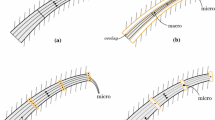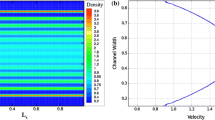Abstract
We present a hybrid molecular-continuum simulation method for modelling nano- and micro-flows in network-type systems. In these types of problem, a full molecular dynamics (MD) description of the macroscopic flow behaviour would be computationally intractable, or at least too expensive to be practical for engineering design purposes. Systems that exhibit multiscale traits, such as this, can instead be solved using a hybrid approach that distinguishes the problem into macroscopic and microscopic dynamics, modelled by their respective solvers. The technique presented in this study is an extension and addition to a hybrid method developed by Borg et al. (J Comput Phys 233:400–413, 2013) for high-aspect-ratio channel geometries, known as the internal-flow multiscale method (IMM). Computational savings are obtained by replacing long channels in the network, which are highly scale-separated, by much smaller, but representative, MD simulations, without a substantial loss of accuracy. On the other hand, junction components do not exhibit this length-scale separation, and so must be simulated in their entirety using MD. The current technique combines all network elements (junctions and channels) together in a coupled simulation using continuum conservation laws. For the case of steady, isothermal, incompressible, low-speed flows, we use the conservation of mass and momentum flux equations to derive a set of molecular-continuum constraints. An algorithm is presented here that computes at each iteration the new constraints on the pressure differences to be applied over individual MD micro-elements (channels and junctions), successively moving closer to macroscopic mass and momentum conservation. We show that hybrid simulations of some example network cases converge quickly, in only a few iterations, and compare very well to the corresponding full MD results, which are taken as the most accurate solutions. Major computational savings can be afforded by the IMM-type approximation in the channel components, but for steady-state solutions, even greater savings are possible. This is because the micro-elements are coupled to a steady-state continuum conservation expression, which greatly speeds up the relaxation of individual micro-components to steady conditions as compared to that of a full MD simulation. Unsteady problems with high temporal scale separation can also be simulated, but general transient problems are beyond the capabilities of the current technique.
















Similar content being viewed by others
Notes
Computed using \([\rho_{\rm max} - \rho_{\rm min}]/ \overline{\rho} \times 100\,\%\).
Computed using [ρ F − ρ H]/ ρ F × 100 %, where F denotes the full-scale result, and H the hybrid result.
Velocity profile measurements have been least-squares fitted with a second degree polynomial and then normalised by the peak velocity at the centre-line.
References
Allen MP, Tildesley DJ (1987) Computer simulation of liquids. Oxford University Press, Oxford
Asproulis N, Kalweit M, Drikakis D (2012) A hybrid molecular continuum method using point wise coupling. Adv Eng Softw 46(1):85–92
Berendsen HJC, Postma JPM, van Gunsteren WF, Dinola A, Haak JR (1984) Molecular dynamics with coupling to an external bath. J Chem Phys 81:3684–3690
Borg MK, Lockerby DA, Reese JM (2013) A multiscale method for micro/nano flows of high aspect ratio. J Comput Phys 233:400–413
Borg MK, Macpherson GB, Reese JM (2010) Controllers for imposing continuum-to-molecular boundary conditions in arbitrary fluid flow geometries. Mol Simul 36(10):745–757
Brooks CL III, Karplus M (1983) Deformable stochastic boundary conditions in molecular dynamics. J Chem Phys 79(12):6312–6325
Delgado-Buscalioni R, Coveney PV (2003) Continuum-particle hybrid coupling for mass, momentum, and energy transfers in unsteady fluid flow. Phys Rev E 67(4):1–13
E W, Bjorn E, Zhongyi H (2003) Heterogeneous multiscale method: a general methodology for multiscale modeling. Phys Rev B 67:092–101
E W, Ren W, Vanden-Eijnden E (2009) A general strategy for designing seamless multiscale methods. J Comput Phys 228:5437–5453
Gad-El-Hak M (2006) MEMS (electronic resource): introduction and fundamentals. 2nd edn. CRC Taylor and Francis, Boca Raton
Hadjiconstantinou N, Patera A (1997) Heterogeneous atomistic-continuum methods for dense fluid systems. Int J Modern Phys C 8(4):967–976
Hadjiconstantinou NG (1999) Hybrid atomistic-continuum formulations and the moving contact-line problem. J Comput Phys 154(2):245–265
Hadjiconstantinou NG (2005) Discussion of recent developments in hybrid atomistic-continuum methods for multiscale hydrodynamics. Bull Polish Acad Sci: Tech Sci 53(4):335–342
Irving JH, Kirkwood JG (1950) The statistical mechanical theory of transport processes. IV. The equations of hydrodynamics. J Chem Phys 18(6):817–829
Jiang H, Weng X, Li D (2011) Microfluidic whole-blood immunoassays. Microfluid Nanofluid 10:941–964
Kazi A, Motakabbir MB (1990) Isothermal compressibility of spc/e water. J Phys Chem 94(21):8359–8362
Koplik J, Banavar JR (1995) Continuum deductions from molecular hydrodynamics. Ann Rev Fluid Mech 27:257–292
Koplik J, Banavar JR, Willemsen JF (1988) Molecular dynamics of Poiseuille flow and moving contact lines. Phys Rev Lett 60:1282–1285
Liang Z, Tsai HL (2012) A method to generate pressure gradients for molecular simulation of pressure-driven flows in nanochannels. Microfluid Nanofluid 13(2):289–298
Lockerby DA, Duque-Daza CA, Borg MK, Reese JM (2013) Time-step coupling for hybrid simulations of multiscale flows. J Comput Phys 237:344–365
Macpherson GB, Reese JM (2008) Molecular dynamics in arbitrary geometries: parallel evaluation of pair forces. Mol Simul 34(1):97–115
Mantzalis D, Asproulis N, Drikakis D (2011) Filtering carbon dioxide through carbon nanotubes. Chem Phys Lett 506(1-3):81–85
Mattia D, Gogotsi Y (2008) Review: static and dynamic behavior of liquids inside carbon nanotubes. Microfluid Nanofluid 5(3):289–305
Mohamed K, Mohamad A (2010) A review of the development of hybrid atomistic-continuum methods for dense fluids. Microfluid Nanofluid 8:283–302
Nicholls WD, Borg MK, Lockerby DA, Reese JM (2012) Water transport through (7,7) carbon nanotubes of different lengths using molecular dynamics. Microfluid Nanofluid 12(1–4):257–264
Nie XB, Chen SY, E W, Robbins MO (2004) A continuum and molecular dynamics hybrid method for micro- and nano-fluid flow. J Fluid Mech 500:55–64
O’Connell ST, Thompson PA (1995) Molecular dynamics–continuum hybrid computations: a tool for studying complex fluid flows. Phys Rev E 52:R5792–R5795
Okumura H, Heyes DM (2004) Comparisons between molecular dynamics and hydrodynamics treatment of nonstationary thermal processes in a liquid. Phys Rev E 70(6):061–206
OpenFOAM. http://www.openfoam.org
Rapaport DC (2004) The art of molecular molecular dynamics simulation. 2nd edn. Cambridge University Press, Cambridge
Ren W, E W (2005) Heterogeneous multiscale method for the modeling of complex fluids and micro-fluidics. J Comput Phys 204(1):1–26
Song Y, Caswell B, Mason EA (1991) Compressibility of liquids: theoretical basis for a century of empiricism. Int J Thermophys 12:855–868
Sun M, Ebner C (1992) Molecular-dynamics simulation of compressible fluid flow in two-dimensional channels. Phys Rev A 46(8):4813–4818
Thompson PA, Troian SM (1997) A general boundary condition for liquid flow at solid surfaces. Nature 389(6649):360–362
Todd BD (2001) Computer simulation of simple and complex atomistic fluids by nonequilibrium molecular dynamics techniques. Comput Phys Commun 142(1-3):14–21
Travis KP, Gubbins KE (2000) Poiseuille flow of Lennard–Jones fluids in narrow slit pores. J Chem Phys 112(4):1984–1994
Travis KP, Todd BD, Evans DJ (1997) Departure from Navier-Stokes hydrodynamics in confined liquids. Phys Rev E 55(4):4288–4295
Travis KP, Todd BD, Evans DJ (1997) Poiseuille flow of molecular fluids. Phys A: Stat Theor Phys 240(1-2):315–327
Wagner G, Flekkøy E, Feder J, Jøssang T (2002) Coupling molecular dynamics and continuum dynamics. J Comput Phys Commun 147:670–673
Werder T, Walther JH, Koumoutsakos P (2005) Hybrid atomistic–continuum method for the simulation of dense fluid flows. J Comput Phys 205(1):373–390
Xi-Jun Fan Nhan Phan-Thien NTY, Diao X (2002) Molecular dynamics simulation of a liquid in a complex nano channel flow. Phys Fluids 14(3):1146–1153
Yarin LP, Mosyak A, Hetsroni G (2009) Fluid flow, heat transfer and boiling in micro-channels. Springer, New York
Yasuda S, Yamamoto R (2008) A model for hybrid simulations of molecular dynamics and computational fluid dynamics. Phys Fluids 20(11):101,113
Zhu F, Tajkhorshid E, Schulten K (2002) Pressure-induced water transport in membrane channels studied by molecular dynamics. Biophys J 83(1):154–160
Zhu F, Tajkhorshid E, Schulten K (2004) Theory and simulation of water permeation in aquaporin-1. Biophys J 86(1):50–57
Acknowledgments
This research is financially supported by the EPSRC Programme Grant EP/I011927/1 and the EPSRC e-Infrastructure Grant EP/K00586/1. The authors would also like to thank the reviewers of this paper for their very helpful comments.
Author information
Authors and Affiliations
Corresponding author
Rights and permissions
About this article
Cite this article
Borg, M.K., Lockerby, D.A. & Reese, J.M. A hybrid molecular-continuum simulation method for incompressible flows in micro/nanofluidic networks. Microfluid Nanofluid 15, 541–557 (2013). https://doi.org/10.1007/s10404-013-1168-y
Received:
Accepted:
Published:
Issue Date:
DOI: https://doi.org/10.1007/s10404-013-1168-y




